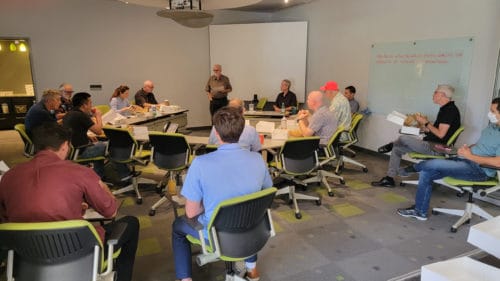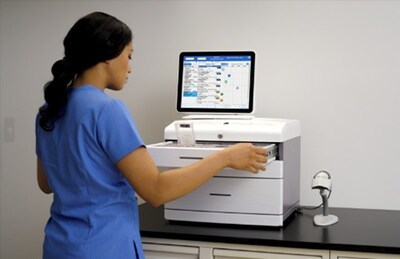Medical device design is a complex industry that demands highly talented teams. Designing a successful medical device requires more than just the technical aspects — it also requires a full understanding of regulatory considerations, commerciality, and of course, expertise in the medical field.
Omnica provides solutions for medical device engineering. We can assist clients with designing, conceptualizing, and transferring designs for new medical devices.
What Are Medical Device Design Services?
Medical design services can cover a wide range of field-specific expertise. As medical devices tend to be quite complex, there are several considerations that can go into a single device. Some of the most common considerations include:
Industrial Design
Industrial design acts as a bridge that connects the device to the people who use it. Successful industrial design will make a device that is easy to use and understand. For example, an industrial designer will consider the location of operator controls, like a screen. Controls need to be placed in a way that they can be accessed by users of varying height.
Mechanical Engineering
Mechanical engineers strive to make a device that is cheaper, more accurate, safer, or more efficient. These engineers focus on many aspects of product design, including system architecture, material selection, component selection, and many other variables.
Electrical Engineering
Electrical engineers play a very important role in designing medical devices, especially for battery-operated implants. A common example is the implantable cardioverter defibrillator. This implant tracks a patient’s heart and sends a jolt of electricity when needed. The safe and efficient operation of these devices is the result of high-quality electrical engineering.
Firmware Engineering
Firmware is permanent software found on a device and is responsible for making sure the hardware operates properly. The firmware typically interacts with the operating system and user interface of a specific device. Firmware can range in complexity. It can be simple which allows easier use, or complex which grants the user more control over the device’s operations. No matter your preference, our firmware engineers can customize the firmware as you see fit.
Software Engineering
Certain software is critical for operation, such as the operating system or user interface. Other software is optional but can enhance the operation or functionality of a medical device. Additionally, the software itself can be a standalone product. This has led to a new sub-industry within medical devices known as “Software as Medical Device” or “SaMD.”
FDA Regulatory Control
No matter the device, it must be compliant with FDA regulations. FDA has three classes of regulation for medical devices. Throughout the entire design stage, we consider the class of the product and the regulatory hurdles it will face, ensuring a smooth approval process.
Medical Device Design: Key Features
Omnica acts as an extension of your company. We provide R&D services for clients who do not have an internal R&D department. Additionally, our R&D team will work hand-in-hand with clients who already have an established internal research and development team. No matter the case, we can extend the R&D capabilities of any client. When a company has more projects than resources, we can provide a beneficial solution.
Prototyping
Our team is quite experienced in our prototyping capabilities. Most clients who outsource prototyping responsibilities to us see a reduction in costs and time to complete prototyping. Our team relies on extensive in-house resources to complete prototyping in a timely and cost-effective manner.
Weekly Review Meetings
No matter how involved we are in a project, we rely on weekly meetings with our clients. This includes a published presentation that documents results and progress. Weekly meetings empower our clients to be informed about project decisions and the progression of the overall project. By providing a published presentation, weekly meetings can be easily shared with others in the organization who are unable to attend the meetings. The published reports make it easy to maintain a complete design history file.
Annotated Invoices
Included in the weekly meetings are detailed invoices. This allows clients to closely monitor costs in relation to progress made. With weekly invoices, unwanted surprises are easily avoided.
Medical Device Development Phases
All our employees are capable of working in every developmental phase. Our Los Angeles facility has advanced modeling capabilities, allowing us to build prototypes in-house. In-house prototyping minimizes mistakes and manufacturing time. In most projects, our team works in three or four phases:
-
Phase 0
Phase 0 is optional on all projects. This phase is implemented if a client doesn’t have documentation of what they want to be designed. This phase entails specifying requirements and details of the product design.
-
Phase 1: Concept Development
After a design’s risks have been identified, conceptual development can begin. This phase entails finding solutions to the device’s problems and rigorous testing to ensure they are properly solved. After testing, a fully functional alpha prototype is created. The alpha prototype undergoes additional testing with data collection. The results of these tests are used in the design of the final product.
-
Phase 2: Design and Development
Phase two consists of the construction of several beta prototypes. These prototypes are fully functional and will resemble the final product. The beta prototypes are tested for different variables separate from the alpha prototype tests. These tests may include safety, electrical prescreens, etc.
-
Phase 3: Design Transfer
After beta testing, the product is ready for manufacturing. Our team will work directly with your manufacturing team to ensure the smooth transfer of all the design specifications.
Medical Device Design: Design Controls
To ensure that medical devices meet expected standards, manufacturers need to comply with design controls established by the FDA. To meet these regulations, we adhere to the following outline during the design process:
- Development and design planning
- Identifying and detailing design inputs
- Developing and providing design outputs
- Verifying that inputs match outputs
- Validation of the design
- Monitoring design changes
- Reviewing and verifying design results
- Proper transfer of design to production
- Creating and maintaining a design history file
The main causes of device recalls can be traced to design issues. This is the main reason why the FDA revised the Current Good Manufacturing Practice (CGMP) in 1996. The regulatory revision includes a section on design controls known as Title 21 CFR Part 820:30.
As part of the revision, makers of medical devices that are considered class II, class III, and some class I devices must adhere to procedures that control a device’s design. This requirement is to ensure that a medical device will meet industry requirements.
Examples of medical devices that are subject to this regulation include:
Class I Devices:
- Wellness apps
- Bedpans
- Elastic bandages
Class II Devices:
- Surgical needles
- Pregnancy testing kits
- X-ray machines
- Apple Watch
Class III Devices:
- Breast implants
- Pacemakers
- Knee implants
Work with Omnica for Medical Device Design Services
Omica is one of the premier medical device firms on the west coast. Our company has over 35 years of experience in the industry. We are capable of working with both small start-ups and fortune 500 companies. Our unique level of experience makes us one of the best engineering partners for medical device design.
contact us




